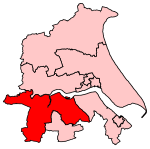Isle of Axholme Rural District
Districts of England abolished by the Local Government Act 1972Districts of England created by the Local Government Act 1894Rural districts of LindseyUse British English from August 2012

Isle of Axholme was a rural district in Lincolnshire, Parts of Lindsey from 1894 to 1974. It was formed under the Local Government Act 1894 based on the Lincolnshire parts of the Thorne rural sanitary district and two parishes of the Goole RSD (covering the northern part of the Isle of Axholme). After the abolition of Crowle Urban District and taking in some parishes from the Gainsborough Rural District in 1936, it covered all of the Isle. It was abolished in 1974 under the Local Government Act 1972 and went to form part of the Boothferry district of Humberside. Since 1996 it has been incorporated in the unitary authority of North Lincolnshire.
Excerpt from the Wikipedia article Isle of Axholme Rural District (License: CC BY-SA 3.0, Authors, Images).Isle of Axholme Rural District
Belton Road,
Geographical coordinates (GPS) Address Nearby Places Show on map
Geographical coordinates (GPS)
| Latitude | Longitude |
|---|---|
| N 53.55 ° | E -0.8 ° |
Address
Belton Road
Belton Road
DN9 1LY
England, United Kingdom
Open on Google Maps








